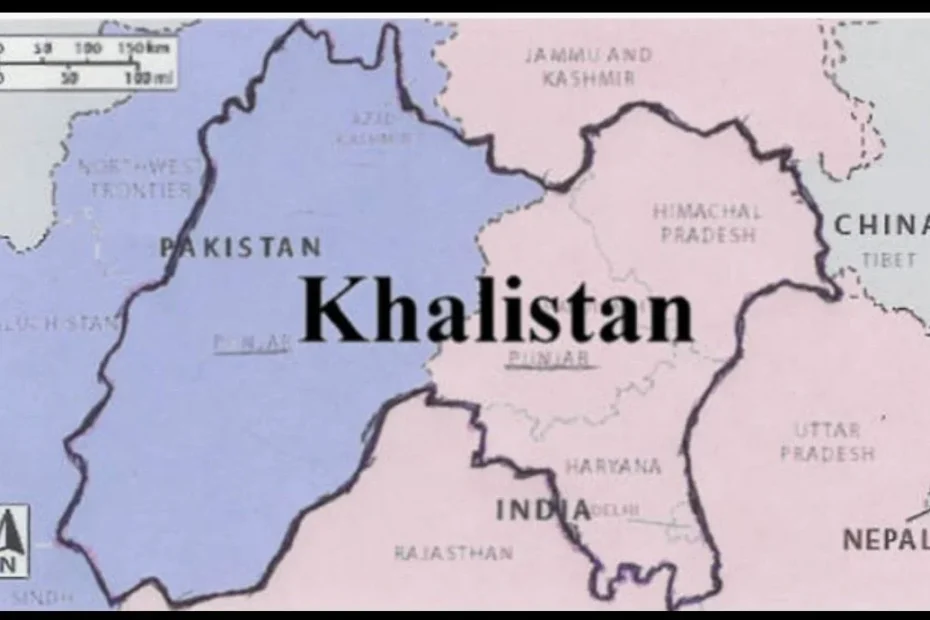The Khalistan movement is a nationalist political liberation movement that aims to establish a new nation in the Punjab region of South Asia called Khalistan (Punjabi:ਖਾਲਿਸਤਾਨ, “The Land of the Pure”). But is this idea real or just a creation of the mind?
States/Territories Claimed Under Khalistan

Different groups have different ideas about where the borders of Khalistan should be; some propose the entire Indian state of Punjab, while others make more expansive claims that include Pakistan’s Punjab and other regions of northern India like Chandigarh, Haryana, and Himachal Pradesh.
The majority of Sikhs moved from Punjab, a region in Pakistan, to Punjab, a province in India, which at the time comprised sections of what is now Haryana and Himachal Pradesh, after the partition was announced. So they claim Haryana and Himachal Pradesh in the Khalistan Map.
Some even claim regions of Rajasthan in the proposed country of Khalistan & its map.
Overview of the Khalistan Movement
This separatist group aims to establish the sovereign state of Khālistān in the Punjab region for the Sikhs. This imaginary state would encompass both Punjab, India, and Punjab, Pakistan, with Lahore as its capital. Originating after the British Empire’s decline, the movement gained momentum in the 1970s and 1980s, fueled by financial and political support from the Sikh diaspora. However, during the 1990s, its insurgency waned due to factors such as a robust police crackdown, internal conflicts, and dwindling support from the Sikh population. While the Khalistan movement retains some backing in India and among the Sikh diaspora, it has yet to realize its goal, with annual protests continuing to commemorate those lost during Operation Blue Star. Notably, the movement has at times expressed aspirations beyond Punjab, including territories in North India and the western Indian states.
Where does the Khalistan Movement stands today?
1. Amritpal Singh
After a sizable mob of his supporters attacked a police station outside of Amritsar in February, the name Amritpal Singh began to circulate.
Amritpal used the incident, which made headlines, as a platform to advocate for an armed rebellion against the government in pursuit of “Khalistan’s” ultimate goal.
Amritpal Singh, a Sikh separatist, was detained by India in April of this year on suspicion of reviving calls for Khalistan and igniting new unrest in Punjab.
2. Indian-Canadian Rift
The murder in June in Canada of a Sikh separatist leader who was pushing for the establishment of an independent Sikh homeland called “Khalistan” sparked credible allegations that Indian government agents were involved, according to Canadian Prime Minister Justin Trudeau, which caused tensions between India and Canada to rise.
History
The Sikhs’ traditional homeland has been the Punjab region. After centuries of rebellion against the oppressive Mughal rule, the Sikhs freed it before the British conquered it. The Sikhs had controlled the area for almost a century. However, there are also a sizable number of Muslims and Hindus in the area. A number of Sikh leaders were concerned that their community would be without a homeland after India was divided between the Hindus and the Muslims when the Muslim League called for a separate nation for Muslims in the Lahore Resolution of 1940. They proposed the creation of Khalistan, a theocratic state spanning the larger Punjab region.
FAQ’s
Q: What is the origin of the term “Khalistan”?
A: The term “Khalistan” is derived from “Khalsa,” which means the community of baptized Sikhs, and “stan,” a Persian word for “land of.” It signifies a land for Sikhs.
Q: Is Khalistan a recognized state?
A: No, Khalistan is not a recognized state. It is a proposed Sikh homeland that has not gained international recognition.
Q: What are the main reasons behind the demand for Khalistan?
A: The demand for Khalistan is driven by a desire for Sikh self-determination, preservation of Sikh culture, and perceived discrimination in India.
Q: How does India respond to the Khalistan demand?
A: India considers the demand for Khalistan as a secessionist movement and has taken measures to counter it. The Indian government views Punjab as an integral part of the country.
Q: What is the current status of the Khalistan movement?
A: The Khalistan movement continues to exist, with varying levels of support and activism. It remains a topic of discussion and debate both within and outside the Sikh community.
Conclusion
In this comprehensive blog, we’ve explored the Khalistan map and the states it claims, providing historical context, geographical boundaries, political insights, international perspectives, socio-cultural significance, and legal considerations. While Khalistan remains a contentious issue, understanding its complexities is essential for anyone interested in South Asian politics and Sikh culture.
checkout our recent blogs at Blogsroom
if you are interested in IPO related content then make sure to check out ipohunts.
If you are Interested in cricket buzzers and updates then make sure to check out crikzone.
